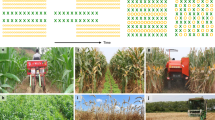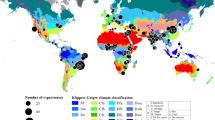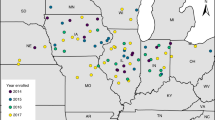Abstract
Population and income growth are increasing global food demand at a time when a third of the world’s agricultural soils are degraded and climate variability threatens the sustainability of food production. Intercropping, the practice of growing two or more spatially intermingled crops, often increases yields, but whether such yield increases, their stability and soil fertility can be sustained over time remains unclear. Using four long-term (10–16 years) experiments on soils of differing fertility, we found that grain yields in intercropped systems were on average 22% greater than in matched monocultures and had greater year-to-year stability. Moreover, relative to monocultures, yield benefits of intercropping increased through time, suggesting that intercropping may increase soil fertility via observed increases in soil organic matter, total nitrogen and macro-aggregates when comparing intercropped with monoculture soils. Our results suggest that wider adoption of intercropping could increase both crop production and its long-term sustainability.
This is a preview of subscription content, access via your institution
Access options
Access Nature and 54 other Nature Portfolio journals
Get Nature+, our best-value online-access subscription
$29.99 / 30 days
cancel any time
Subscribe to this journal
Receive 12 digital issues and online access to articles
$119.00 per year
only $9.92 per issue
Buy this article
- Purchase on Springer Link
- Instant access to full article PDF
Prices may be subject to local taxes which are calculated during checkout




Similar content being viewed by others
Data availability
The data that support the findings of this study are available in Supplementary Data 1 and from the corresponding author upon request. Source data are provided with this paper.
Code availability
The custom code generated for this study is available in the Supplementary Information and from the corresponding author upon request.
References
Laurance, W. F., Sayer, J. & Cassman, K. G. Agricultural expansion and its impacts on tropical nature. Trends Ecol. Evol. 29, 107–116 (2014).
Bélanger, J. & Pilling, D. (eds) The State of the World’s Biodiversity for Food and Agriculture (FAO Commission on Genetic Resources for Food and Agriculture, 2019).
Rockström, J. et al. Sustainable intensification of agriculture for human prosperity and global sustainability. Ambio 46, 4–17 (2017).
Pretty, J. et al. Global assessment of agricultural system redesign for sustainable intensification. Nat. Sustain. 1, 441–446 (2018).
Renard, D. & Tilman, D. National food production stabilized by crop diversity. Nature 571, 257–260 (2019).
Tilman, D. Benefits of intensive agricultural intercropping. Nat. Plants 6, 604–605 (2020).
Gomez, A. A. & Gomez, K. A. Multiple Cropping in the Humid Tropics of Asia (IDRC, 1983).
Li, L. et al. Diversity enhances agricultural productivity via rhizosphere phosphorus facilitation on phosphorus-deficient soils. Proc. Natl Acad. Sci. USA 104, 11192–11196 (2007).
Li, C. J. et al. Syndromes of production in intercropping impact yield gains. Nat. Plants 6, 653–660 (2020).
Xu, Z. et al. Intercropping maize and soybean increases efficiency of land and fertilizer nitrogen use; a meta-analysis. Field Crops Res. 246, 107661 (2020).
Zhu, Y. Y. et al. Genetic diversity and disease control in rice. Nature 406, 718–722 (2000).
Li, W. X. et al. Effects of intercropping and nitrogen application on nitrate present in the profile of an Orthic Anthrosol in Northwest China. Agric. Ecosyst. Environ. 105, 483–491 (2005).
Manevski, K., Borgesen, C. D., Andersen, M. N. & Kristensen, I. S. Reduced nitrogen leaching by intercropping maize with red fescue on sandy soils in North Europe: a combined field and modeling study. Plant Soil 388, 67–85 (2015).
Tilman, D., Reich, P. B. & Knops, J. M. H. Biodiversity and ecosystem stability in a decade-long grassland experiment. Nature 441, 629–632 (2006).
Roscher, C. et al. Identifying population- and community-level mechanisms of diversity–stability relationships in experimental grasslands. J. Ecol. 99, 1460–1469 (2011).
Zhou, B. R. et al. Plant functional groups asynchrony keep the community biomass stability along with the climate change—a 20-year experimental observation of alpine meadow in eastern Qinghai-Tibet Plateau. Agric. Ecosyst. Environ. 282, 49–57 (2019).
Schnabel, F. et al. Drivers of productivity and its temporal stability in a tropical tree diversity experiment. Glob. Change Biol. 25, 4257–4272 (2019).
Pohl, M., Alig, D., Körner, C. & Rixen, C. Higher plant diversity enhances soil stability in disturbed alpine ecosystems. Plant Soil 324, 91–102 (2009).
Pérès, G. et al. Mechanisms linking plant community properties to soil aggregate stability in an experimental grassland plant diversity gradient. Plant Soil 373, 285–299 (2013).
Gould, I. J., Quinton, J. N., Weigelt, A., De Deyn, G. B. & Bardgett, R. D. Plant diversity and root traits benefit physical properties key to soil function in grasslands. Ecol. Lett. 19, 1140–1149 (2016).
Lange, M. et al. Plant diversity increases soil microbial activity and soil carbon storage. Nat. Commun. 6, 6707 (2015).
Dybzinski, R., Fargione, J. E., Zak, D. R., Fornara, D. & Tilman, D. Soil fertility increases with plant species diversity in a long-term biodiversity experiment. Oecologia 158, 85–93 (2008).
Tisdall, J. M. & Oades, J. M. Organic matter and water-stable aggregates in soils. J. Soil Sci. 33, 141–163 (1982).
Amézketa, E. Soil aggregate stability: a review. J. Sustain. Agric. 14, 83–151 (1999).
Six, J., Bossuyt, H., Degryze, S. & Denef, K. A history of research on the link between (micro)aggregates, soil biota, and soil organic matter dynamics. Soil Tillage Res. 79, 7–31 (2004).
Tiemann, L. K., Grandy, A. S., Atkinson, E. E., Marin-Spiotta, E. & McDaniel, M. D. Crop rotational diversity enhances belowground communities and functions in an agroecosystem. Ecol. Lett. 18, 761–771 (2015).
Christensen, B. T. & Johnston, A. E. in Developments in Soil Science (eds Gregorich, E. G. & Carter, M. R.) 399–430 (Elsevier, 1997).
Fornara, D. A. & Tilman, D. Soil carbon sequestration in prairie grasslands increased by chronic nitrogen addition. Ecology 93, 2030–2036 (2012).
Cong, W. F. et al. Plant species richness promotes soil carbon and nitrogen stocks in grasslands without legumes. J. Ecol. 102, 1163–1170 (2014).
Zhang, W. F. et al. Closing yield gaps in China by empowering smallholder farmers. Nature 537, 671–674 (2016).
Wan, N. F. et al. Global synthesis of effects of plant species diversity on trophic groups and interactions. Nat. Plants 6, 503–510 (2020).
Isbell, F. et al. Benefits of increasing plant diversity in sustainable agroecosystems. J. Ecol. 105, 871–879 (2017).
Status of the World’s Soil Resources Main Report (FAO and ITPS, 2015).
Jensen, E. S. & Williamson, S. in Replacing Chemicals with Biology: Phasing Out Highly Hazardous Pesticides with Agroecology (eds Watts, M. & Williamson, S.) 162–167 (Pestice Action Network International, 2015).
Bender, S. F., Wagg, C. & van der Heijden, M. G. A. An underground revolution: biodiversity and soil ecological engineering for agricultural sustainability. Trends Ecol. Evol. 31, 440–452 (2016).
Zhang, R. Z. et al. Response of the arbuscular mycorrhizal fungi diversity and community in maize and soybean rhizosphere soil and roots to intercropping systems with different nitrogen application rates. Sci. Total Environ. 740, 139810 (2020).
Bao, S. D. Analysis on Soil and Agricultural Chemistry (China Agricultural Press, 2005).
Kemper, W. D. & Rosenau, R. C. Aggregate Stability and Size Distribution: Methods of Soil Analysis, Part 1 Physical and Mineralogical Methods (American Society of Agronomy, 1986).
Willey, R. W. Evaluation and presentation of intercropping advantages. Exp. Agric. 21, 119–133 (1985).
van Ruijven, J. & Berendse, F. Contrasting effects of diversity on the temporal stability of plant populations. Oikos 116, 1323–1330 (2007).
The Price Division, National Development and Reform Commission of China The National Agricultural Products Cost–Benefit Compilation of Information (China Statistics Press, 2010–2019).
R Core Team R: A Language and Environment for Statistical Computing v.3.6.2 (R Foundation for Statistical Computing, 2019).
Acknowledgements
We thank all members involved in the maintenance of the long-term field experiments. We also thank H. Xu (Hebei Agricultural University) for advice on yield detrending method and X. Li (CSIRO Agriculture and Food) for assistance on data analysis and visualization. This work was supported financially by the National Natural Science Foundation of China (31430014), the National Key Research and Development Program of China (2016YFD0300202) and the National Basic Research Program of China (973 Program) (2011CB100405). R.M.C. thanks the National Science Foundation EPSCoR Cooperative Agreement OIA-1757351 for partial support.
Author information
Authors and Affiliations
Contributions
L.L., X.-F.L., Z.-G.W., J.-H.S., X.-G.B. and S.-C.Y. designed the research; X.-F.L., Z.-G.W., X.-G.B., J.-H.S., S.-C.Y., P.W, C.-B.W., J.-P.W., X.-R.L., X.-L.T, Yu Wang, J.-P.L., Yan Wang, H.-Y.X., P.-P.M., X.-F.W., J.-H.Z., R.-P.Y., W.-P.Z., Z.-X.C., L.-G.G. and L.L. performed research; X.-F.L., Z.-G.W., R.-P.Y. and L.L. analysed the data; and X.-F.L., Z.-G.W., R.M.C., D.T. and L.L. wrote the paper.
Corresponding author
Ethics declarations
Competing interests
The authors declare no competing interests.
Additional information
Peer review information Nature Sustainability thanks Wen-Feng Cong, Matthew Ryan and Christian Schöb for their contribution to the peer review of this work.
Publisher’s note Springer Nature remains neutral with regard to jurisdictional claims in published maps and institutional affiliations.
Supplementary information
Supplementary Information
Supplementary Figs. 1–3 and Tables 1–4.
Supplementary Data 1
Statistical source data for Supplementary Figs. 2 and 3.
Source data
Source Data Fig. 1
Statistical source data for Fig. 1.
Source Data Fig. 2
Statistical source data for Fig. 2.
Source Data Fig. 3
Statistical source data for Fig. 3.
Source Data Fig. 4
Statistical source data for Fig. 4.
Rights and permissions
About this article
Cite this article
Li, XF., Wang, ZG., Bao, XG. et al. Long-term increased grain yield and soil fertility from intercropping. Nat Sustain 4, 943–950 (2021). https://doi.org/10.1038/s41893-021-00767-7
Received:
Accepted:
Published:
Issue Date:
DOI: https://doi.org/10.1038/s41893-021-00767-7
This article is cited by
-
A global dataset of experimental intercropping and agroforestry studies in horticulture
Scientific Data (2024)
-
Legume rhizodeposition promotes nitrogen fixation by soil microbiota under crop diversification
Nature Communications (2024)
-
Intercropping indices evaluation on grain legume-small grain cereals mixture: a critical meta-analysis review
Agronomy for Sustainable Development (2024)
-
Intercropping-induced leaf metabolic changes increase plant resistance to herbivory
Plant and Soil (2024)
-
Associational Effects of Desmodium Intercropping on Maize Resistance and Secondary Metabolism
Journal of Chemical Ecology (2024)



